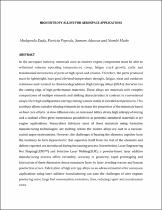JavaScript is disabled for your browser. Some features of this site may not work without it.
- ResearchSpace
- →
- Research Publications/Outputs
- →
- Book Chapters
- →
- View Item
| dc.contributor.author |
Dada, M

|
|
| dc.contributor.author |
Popoola, P

|
|
| dc.contributor.author |
Adeosun, S

|
|
| dc.contributor.author |
Mathe, Ntombizodwa R

|
|
| dc.date.accessioned | 2020-07-27T06:13:11Z | |
| dc.date.available | 2020-07-27T06:13:11Z | |
| dc.date.issued | 2019-09 | |
| dc.identifier.citation | Dada, M. et al. 2019. High entropy alloys for aerospace applications. In: Environmental Impact of Aviation and Sustainable Solutions. IntechOpen | en_US |
| dc.identifier.uri | DOI: 10.5772/intechopen.84982 | |
| dc.identifier.uri | https://www.intechopen.com/online-first/high-entropy-alloys-for-aerospace-applications | |
| dc.identifier.uri | http://hdl.handle.net/10204/11502 | |
| dc.description | Copyright 2019. The Authors. This is an open access article under the terms of the Creative Commons Attribution License, which permits use, distribution and reproduction in any medium, provided the original work is properly cited. | en_US |
| dc.description.abstract | In the aerospace industry, materials used as modern engine components must be able to withstand extreme operating temperatures, creep, fatigue crack growth and translational movements of parts at high speed. Therefore, the parts produced must be lightweight and have good elevated-temperature strength, fatigue, resistant to chemical degradation, wear and oxidation resistance. High entropy alloys (HEAs) characterize the cutting edge of high-performance materials. These alloys are materials with complex compositions of multiple elements and striking characteristics in contrast to conventional alloys; their high configuration entropy mixing is more stable at elevated temperatures. This attribute allows suitable alloying elements to increase the properties of the materials based on four core effects , which gives tremendous possibilities as potential structural materials in jet engine applications. Researchers fabricate most of these materials using formative manufacturing technologies; arc melting. However, the challenges of heating the elements together have the tendency to form hypoeutectic that separates itself from the rest of the elements and defects reported are introduced during the casting process. Nevertheless, Laser Engineering Net Shaping (LENS™) and Selective Laser Melting (SLM); a powderbased laser additive manufacturing process offers versatility, accuracy in geometry and fabrication of three-dimensional dense structures layer by layer avoiding production errors. | en_US |
| dc.language.iso | en | en_US |
| dc.relation.ispartofseries | Workflow;22938 | |
| dc.subject | High entropy alloys | en_US |
| dc.subject | Laser additive manufacturing | en_US |
| dc.subject | Laser scan strategies | en_US |
| dc.title | High entropy alloys for aerospace applications | en_US |
| dc.type | Book Chapter | en_US |
| dc.identifier.apacitation | Dada, M., Popoola, P., Adeosun, S., & Mathe, N. R. (2019). High entropy alloys for aerospace applications., <i>Workflow;22938</i> http://hdl.handle.net/10204/11502 | en_ZA |
| dc.identifier.chicagocitation | Dada, M, P Popoola, S Adeosun, and Ntombizodwa R Mathe. "High entropy alloys for aerospace applications" In <i>WORKFLOW;22938</i>, n.p.: n.p. 2019. http://hdl.handle.net/10204/11502. | en_ZA |
| dc.identifier.vancouvercitation | Dada M, Popoola P, Adeosun S, Mathe NR. High entropy alloys for aerospace applications.. Workflow;22938. [place unknown]: [publisher unknown]; 2019. [cited yyyy month dd]. http://hdl.handle.net/10204/11502. | en_ZA |
| dc.identifier.ris | TY - Book Chapter AU - Dada, M AU - Popoola, P AU - Adeosun, S AU - Mathe, Ntombizodwa R AB - In the aerospace industry, materials used as modern engine components must be able to withstand extreme operating temperatures, creep, fatigue crack growth and translational movements of parts at high speed. Therefore, the parts produced must be lightweight and have good elevated-temperature strength, fatigue, resistant to chemical degradation, wear and oxidation resistance. High entropy alloys (HEAs) characterize the cutting edge of high-performance materials. These alloys are materials with complex compositions of multiple elements and striking characteristics in contrast to conventional alloys; their high configuration entropy mixing is more stable at elevated temperatures. This attribute allows suitable alloying elements to increase the properties of the materials based on four core effects , which gives tremendous possibilities as potential structural materials in jet engine applications. Researchers fabricate most of these materials using formative manufacturing technologies; arc melting. However, the challenges of heating the elements together have the tendency to form hypoeutectic that separates itself from the rest of the elements and defects reported are introduced during the casting process. Nevertheless, Laser Engineering Net Shaping (LENS™) and Selective Laser Melting (SLM); a powderbased laser additive manufacturing process offers versatility, accuracy in geometry and fabrication of three-dimensional dense structures layer by layer avoiding production errors. DA - 2019-09 DB - ResearchSpace DP - CSIR KW - High entropy alloys KW - Laser additive manufacturing KW - Laser scan strategies LK - https://researchspace.csir.co.za PY - 2019 T1 - High entropy alloys for aerospace applications TI - High entropy alloys for aerospace applications UR - http://hdl.handle.net/10204/11502 ER - | en_ZA |






